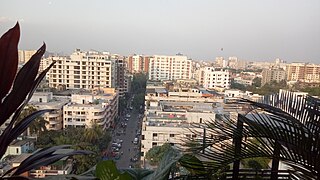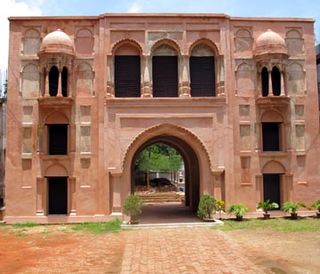
Dhaka Division is an administrative division within Bangladesh. Dhaka serves as the capital city of the Dhaka Division, the Dhaka District and Bangladesh. The division remains a population magnet, covers an area of 20,508.8 km2 with a population in excess of 44 million, It is the most populous country second level division of the world, growing at 1.94% rate since prior count, compared with national average of 1.22%. However, national figures may include data skewing expatriation of male labor force as gender ratio is skewed towards females.

Dhaka (Dacca) is a modern megacity with origins dating to circa the 7th century CE. The history of Dhaka region begins with the existence of urbanised settlements that were ruled by Gangaridai, Gupta Empire, Gauda Kingdom and Buddhist or Shaivite Pala Empire before passing to the control of the Hindu Sena dynasty in the 10th century CE. After the reign of Sena dynasty, the region was ruled by the Hindu Deva dynasty.

Shahbagh is a major neighbourhood and a police precinct or thana in Dhaka, the capital and largest city of Bangladesh. It is also a major public transport hub. It is a junction between two contrasting sections of the city—Old Dhaka and New Dhaka—which lie, respectively, to its south and north. Developed in the 17th century during Mughal rule in Bengal, when Old Dhaka was the provincial capital and a centre of the flourishing muslin industry, it came to neglect and decay in early 19th century. In the mid-19th century, the Shahbagh area was developed as New Dhaka became a provincial centre of the British Raj, ending a century of decline brought on by the passing of Mughal rule.

Mirza Abu Talib, better known as Shaista Khan, was a general and the Subahdar of Mughal Bengal, he was maternal uncle to the Mughal Emperor Aurangzeb, he acted as a key figure during his reign, Shaista Khan initially governed the Deccan, where he clashed with the Maratha ruler Shivaji, However, he was most notable for his tenure as the governor of Bengal from 1664 to 1688, Under Shaista Khan's authority, the city of Dhaka and Mughal power in the province attained its greatest heights. His achievements include constructions of notable mosques such as the Sat Gambuj Mosque and masterminding the conquest of Chittagong. Shaista Khan was also responsible for sparking the outbreak of the Anglo-Mughal War with the English East India Company.

Dhanmondi is an upscale residential and commercial neighbourhood and a thana in Dhaka, Bangladesh, known for its central location, cultural vibrancy and being home to the country's founder, Sheikh Mujibur Rahman. Dhanmondi Thana falls within the administrative areas of both the Dhaka North and Dhaka South city corporations. It fully encompasses wards 49 and partially includes wards 47 and 48.

Ramna is a thana (precinct) in central Dhaka and a historic colonial neighbourhood. Once the site of Mughal gardens, it developed into an institutional area during British rule in the late 19th century. It became a focal point for Dhaka's modernisation in the 1960s. It was the scene of many tumultuous events that ushered the independence of Bangladesh in 1971. Ramna Thana falls under the jurisdiction of Dhaka South City Corporation.

Hakim Habibur Rahman was an Unani physician, litterateur, journalist, politician and chronicler in early 20th-century Dhaka.

Ibrahim Shah Sultan Balkhi, also known by his sobriquet, Mahisawar, was a 16th-century Muslim saint. He is associated with the spread of Islam in Sandwip and Bogra.

Shamsuddīn Aḥmad Shāh was the last Sultan of Bengal belonging to the House of Ganesha. He was the son and successor of Sultan Jalaluddin Muhammad Shah. After his father's death, he ascended the throne at the age of 14.

Nāsir ad-Dīn Naṣrat Shāh, also known as Nusrat Shah, was the second Sultan of Bengal belonging to the Hussain Shahi dynasty. He continued with his father's expansionist policies but by 1526, had to contend with the Mughal ascendency in the Battle of Ghaghra. Simultaneously, Nasrat Shah's reign also suffered a reverse at the hands of the Ahom kingdom. The reigns of Alauddin Husain Shah and Nasrat Shah are generally regarded as the "golden age" of the Bengal Sultanate.
Mirza Ibrahim Beg, later known as Ibrahim Khan Fath-i-Jang was the Subahdar of Bengal during the reign of Mughal emperor Jahangir. He was the brother to Empress Nur Jahan.
Wari is an upscale historical neighbourhood and a thana in Dhaka District in Dhaka Division, Bangladesh. Located in the Old Dhaka quarter, it is the first planned neighbourhood in Dhaka city, established in the late 19th century. The area is home to the Baldha Garden, one of the oldest botanical gardens established in this part of Bengal.

The city of Chattogram (Chittagong) is traditionally centred around its seaport which has existed since the 4th century BCE. One of the world's oldest ports with a functional natural harbor for centuries, Chittagong appeared on ancient Greek and Roman maps, including on Ptolemy's world map. Chittagong port is the oldest and largest natural seaport and the busiest port of Bay of Bengal. It was located on the southern branch of the Silk Road. The city was home to the ancient independent Buddhist kingdoms of Bengal like Samatata and Harikela. It later fell under of the rule of the Gupta Empire, the Gauda Kingdom, the Pala Empire, the Chandra Dynasty, the Sena Dynasty and the Deva Dynasty of eastern Bengal. Arab Muslims traded with the port from as early as the 9th century. Historian Lama Taranath is of the view that the Buddhist king Gopichandra had his capital at Chittagong in the 10th century. According to Tibetan tradition, this century marked the birth of Tantric Buddhism in the region. The region has been explored by numerous historic travellers, most notably Ibn Battuta of Morocco who visited in the 14th century. During this time, the region was conquered and incorporated into the independent Sonargaon Sultanate by Fakhruddin Mubarak Shah in 1340 AD. Sultan Ghiyasuddin Azam Shah constructed a highway from Chittagong to Chandpur and ordered the construction of many lavish mosques and tombs. After the defeat of the Sultan of Bengal Ghiyasuddin Mahmud Shah in the hands of Sher Shah Suri in 1538, the Arakanese Kingdom of Mrauk U managed to regain Chittagong. From this time onward, until its conquest by the Mughal Empire, the region was under the control of the Portuguese and the Magh pirates for 128 years.

The Naib Nazim of Dhaka, officially the Naib Nazim of Jahangir Nagar, was the chief political officer in the city of Dhaka, the present-day capital of Bangladesh, between the mid-18th and mid-19th centuries. It was the second highest office in the political hierarchy of Subah of Bengal, including a nominal position during the East India Company's occupation of Bengal.
Dhakaiya Kutti Bengali, also known as Old Dhakaiya Bengali or simply Dhakaiya, is a Bengali dialect, spoken by the Kutti-Bengalis of Old Dhaka in Bangladesh. This dialect is fully mutually intelligible with Standard Bengali but has some differences in vocabulary. It is not used in formal settings anymore although historically the local Bais and Bara panchayets are said to have used it sometimes.

Tanda, also known as Tandah and Khwaspur Tandah, was a historic 16th-century city of Bengal in the eastern part of South Asia, and one of the most prominent medieval capitals; serving the Karrani Sultans of Bengal and the early Mughal governors of Bengal.

Nūr Qut̤b ʿĀlam was a 14th-century Bengali Islamic scholar, author and poet. Based in the erstwhile Bengali capital Hazrat Pandua, he was the son and successor of Alaul Haq, a senior scholar of the Bengal Sultanate. He is noted for his efforts in preserving the Muslim rule of Bengal against Raja Ganesha and pioneering the Dobhashi tradition of Bengali literature.

Shāh Nūrī Bengālī was an 18th-century Bengali Islamic scholar and author from Dhaka. He is best known for his magnum opus, Kibrīt-e-Aḥmar, which was written in the Persian language.
Dhaka City Museum is a local museum, situated in Nagar Bhaban, Dhaka. This museum was established in 1987 to present the history of Dhaka city to the public, which later became government ownership in 1996.
Paribagh is a neighborhood of Dhaka. It is situated in the north of Shahbagh. It was once the residence of the Dhaka Nawab family. It is now popular for the food street located on Old Elephant Road.














